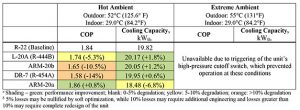The viability of new lower GWP alternative refrigerants in high ambients are said to have been proven in new tests.
The drop-in tests on R22 and R410A rooftop air conditioning units were carried out by the US-government-backed Oak Ridge National Laboratory (ORNL) in response to concerns over whether HFC alternatives would be able to perform well in hot and extremely hot temperatures.
ORNL says the results demonstrate that several viable replacements exist for both R22 and R410A and that these potential replacements perform just as well at high temperatures as today’s refrigerants.
The test results reveal several viable alternatives that perform just as well at high temperatures as today’s refrigerants.
In many cases there was an improvement in the performance of rooftop units (RTU) using the alternatives versus the baseline, both in terms of COP and cooling capacity. In other cases, the performance of the alternatives fell within 10% of the baseline, which suggests that parity with baseline performance would likely be possible through soft optimisation.
ORNL chose units specifically designed for high-ambient conditions. The R22 unit selected was a 7.7TR unit manufactured by Sharjah-based manufacturer SKM. The R410A unit of 11TR was provided by Jordanian manufacturer Petra.
All the alternatives tested were A2L “mildly flammable” refrigerants. The best known is R32, the only single-component refrigerant under test, which is already being used in new small splits around the world.
Those tested for R22 replacement were:
R444B: Developed by Honeywell and marketed as Solstice L20. A blend of R32, R1234ze(E) and R152a. GWP <300.
ARM-20b: An Arkema refrigerant with a GWP of 251
R454A: Developed by Chemours as DR-7 and now being marketed as Opteon XL40. A blend of R1234yf and R32 with a GWP of 238.
ARM-20a: Another Arkema refrigerant. Pending ASHRAE approval as R457A. GWP 139.
The R410A alternatives tested were:
DR-55: A Chemours refrigerant pending ASHRAE approval as R452B. Blend of R32, R1234yf and R125. GWP of 698.
L41z: A Honeywell refrigerant pending approval as R447B. Blend of R32, R125 and R1234ze(E). GWP of 740.
ARM-71a: An Arkema development refrigerant with a GWP of 460.
R32: Single component refrigerant being pioneered by Daikin and now being employed by many leading manufacturers in smaller splits. GWP 675.
R22 results
All showed promising results. Three alternative refrigerants closely matched or exceeded the baseline cooling capacity at all test conditions.
The individual COP results were mixed; two refrigerants, ARM-20a and L-20A (R444B), exhibited results within ~6% of R22 at all test conditions. At hot ambient conditions, ARM-20a exhibited a COP that was 0.8% better than R22 and L-20A (R-444B) had a cooling capacity 1.8% better.

R410A results
Tests again returned promising results.
Three of the four alternative refrigerants exhibited COPs at all testing conditions that exceeded those measured with the baseline R410A.
At high ambient temperatures (hot and extreme conditions), L41z (R447B) and ARM-71a both exceeded the COP of the baseline by more than 7%, with cooling capacities within +3% of R410A. However, all the alternative refrigerants exhibited higher compressor discharge temperatures than R410A, which, the report recognises, may negatively impact compressor reliability. Conversely, the reduction in compressor discharge temperatures exhibited by the R22 alternatives can improve compressor reliability.


As these were drop-in tests, the report compilers expect that the efficiency and capacity of the alternatives would be improved by products specifically designed equipment for those refrigerants.
Improved heat transfer circuiting, proper compressor sizing and selection, and other system improvements would likely yield better performance results for all of the alternative refrigerants.
Source: http://www.coolingpost.com/world-news/low-gwp-refrigerants-win-at-high-ambients/





